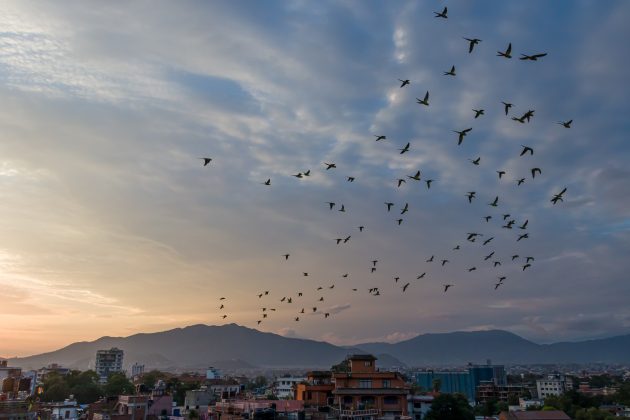My very first Rose-ringed Parakeet was sitting in my dad’s plane tree in the middle of “the winter of discontent”. The Iron Lady was moving into power and The Clash were topping the charts. In the Netherlands, hopes were high for the Eleven-city Tour, but the nation had to wait another 5 years for the first tour during my lifetime, in 1984. Sleet, snow, temperatures dropping to minus 20 degrees Celsius at night, the beautiful green parrot would be a goner by the end of the week, a parrot no more, bereft of life, joined the choir of the invisible, pushing up the daisies. However, unlike the Norwegian Blue (lovely plumage) the Rose-ringed Parakeet did survive and thrive, and how.

The Rose-ringed Parakeet and I reconnected at Rajahmundry railway station, in Andhra Pradesh, India. On my way back to Chennai, after a few weeks of work on an oil installation I was anxious to return home. A flock of loudly screeching parakeets jolted me from my boredom-induced daydreaming. Bright green, blue tail, red beak, kweeek, kweeek, kweeek. The sighting brought a smile to my face, happy days, what could possibly go wrong? Famous last words as the saying goes, for 10 hours later my train derailed at Nellore and while nobody died, it was a gory bloodbath. The Rose-ringed Parakeet in question was the Indian Rose-ringed Rarakeet (Psittacula krameri manillensis), which is the subspecies most likely to turn up in your garden or local park as an invasive species.

The subspecies Abyssinian Rose-ringed Parakeet (P. k. parvirostris) showed itself in even larger numbers during yet another business trip. In the centre of Djibouti lay a little square with what could be called a derelict building if not all buildings looked remarkably alike. This building stood out as it was covered with parakeets. The Horn of Africa isn’t a great place for lush trees so this building may well have served as the local roost. My guesstimate ran up in the hundreds of parakeets. The Rose-ringed Parakeet is native to these parts but with the disjunct distribution area of the subspecies I am hoping for a split. As I was not going to be on a train I felt much better about this sighting. Naturally, I nearly missed my flight to Addis Abeba because my taxi driver picked up another passenger and my Somali/Yemeni/French wasn’t good enough to convince my chauffeur to go straight to the airport first. My fellow passenger cried the entire ride; the reason for which became clear once we reached a large funeral. “Mon frère”, he sobbed when we said goodbye, reminding me there are worse things than missing a flight.

I have already mentioned the invasive character of the Rose-ringed Parakeet and it is being accused of the most dreadful crimes against nature. How bad is it really? On a scale of zero to ten, with zero being no harm done and ten being the acts of the small-minded and spiteful Dutch minister for Housing? The impact seems to be very close to zero… Contrary to popular opinion, our green friends cause remarkably little damage. Native birds being pushed out of their nest holes? Evidence for such negative impact is lacking while anecdotes exist of Jackdaws killing parakeets (and eating their brains while still alive – the horror!) and photographic evidence of Peregrine Falcon hunting them. Methinks the evidence exonerates our winged green apples from any malfeasance towards the natives.

That single bird in the plane tree in 1979 has since gone forth and multiplied to the level that there are now 20,000 parakeets in the Netherlands, which is a whopping 20% of the European Rose-ringed Parakeets population. They are thriving and enlivening our cities and neighbourhoods. I just bought a new house – the garden is home to a small flock of Rose-ringed Parakeets. Why does one buy a house? Location, location, location, right?

One final story to underline the importance of green parakeets in our monochromatic cities where all large birds are black (crows), white (gulls) or black-and-white (magpies). The owner of a small zoo in Brussels, Belgium released a small population in 1974. The reason? He wanted to make Brussels more colourful. Give that man a medal!

Source link
